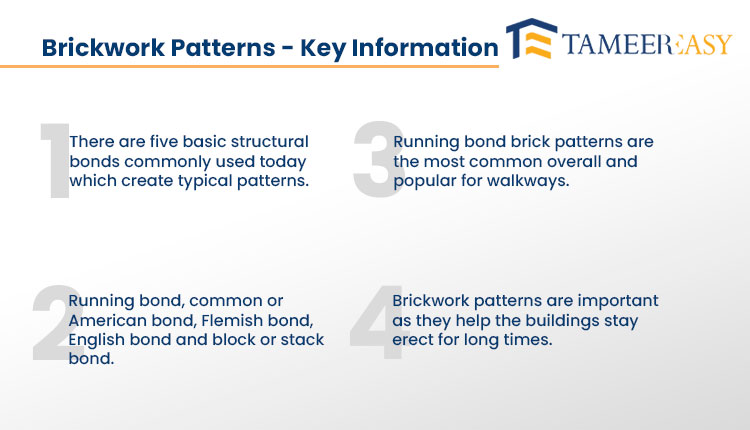It is a well-understood fact that brickwork plays the most crucial role in strengthening the building and imparting beauty to the structure. So if you are constructing a house, you must know all technicalities and patterns of brickwork. Like types of bricks, methods of applying and critical preventive measures to take during the process.
Visit TameerEasy Store to Purchase Quality Construction Items
Here in this article, we will explain all this valuable information to familiarise you with brickwork and the different patterns involved in the process. Let’s have a brief look at it.
Brickwork – Key Information
There are a few terms related to brickwork that you should know. Here are they:
- A brick is a block of soil having a length of 9 inches, a width of 4.5 inches and a thickness of 3 inches.
- The length of the brick is called a stretcher, commonly known as Bi (بائی).
- The width of the brick is known as the header, and in layman’s language, it is سیرو.
- The side having the thickness of the brick is called the face.
- When we join brickworks to make the structure, it is called course or layer, while masons call it ردہ. It has a thickness of 3 inches as bricks.
Different Patterns of Brickwork
Here are some different types of brickwork patterns:
Stretcher Bond
In this brickwork pattern, bricks are applied length-wise, meaning we can only see their stretcher.
English Bond
In the English Bond pattern, the first course or layer (ردہ) has bricks in a stretcher pattern. On the other hand, the layer above and below has bricks with a header side in front. In Pakistan, the masons generally follow the English Bond pattern.
Flemish Bond
A Flemish Bond is a pattern in which we apply bricks in both designs in one layer. The first one will be a stretcher, then the header and the same pattern will go on throughout the course. This pattern is generally used in 13 inches brickwork and can also be used in 9 inches.
Dutch Bond
Dutch Bond is the same as English Bond with the difference that bricks are placed in a way that the header combines with the stretcher in the centre. You just keep on following this pattern throughout the course.

Important Points to Consider During Brickwork
- Always use properly cooked bricks instead of using poor-quality material.
- Use bricks having the perfect size and pattern.
- Do remember that the strength of brickwork is connected to your foundation. So always make a strong foundation.
- While making mortar for brickwork, use the correct water and cement ratio.
- While laying bricks, keep the line proper and joints even. The thickness in all joints should be equal. Typically, we keep it between 10 to 12 mm.
- Keep watering the brickwork as soon as the work is finished.
- Try to use mortar within three to four hours of making it.
- Lastly, avoid overloading of brickwork, which means never constructing 4.5 inches wall of more than 3.5 to 4 feet in a single day. Similarly, in 9 inches wall, only apply something if the material is fully set.
Closing Remarks
To sum up, there are a lot of brickwork patterns which you can use in your building. We hope that you have come to know about all of them. Now you can help yourself a lot during the construction process. Still, if you have any questions or concerns about brickwork or any other construction process, you can contact us through our website, tameereasy.com.







